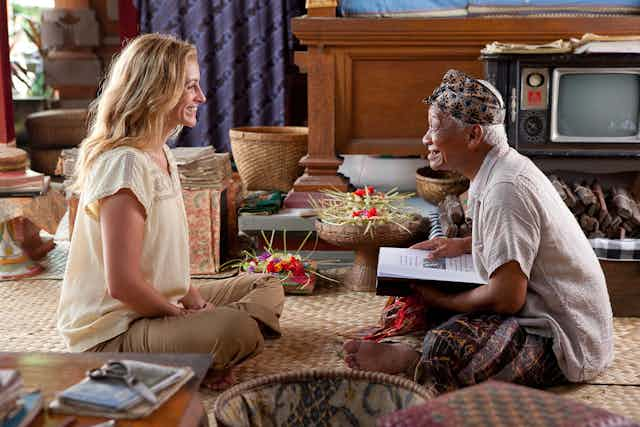Today, modern yoga - once considered the esoteric pursuit of Indian ascetics - has fans all over the world. The global yoga industry is valued at US$5.7 billion, with an estimated 15 million devotees in America alone professing to some sort of yoga practice.
But yoga isn’t just important because it helps practitioners find health, wellness or spiritual depth. Increasingly, yoga also allows people to tell new stories about themselves and how they fit in a globalising present.
In recent decades, a “yoga fiction” genre has begun to crop up in English-language bookstores. As yoga memoirs also known as “yogoirs”, yoga chick lit, yoga comedies and yoga murder mysteries flood the literary marketplace in the West, they change the way we think about one of India’s most popular cultural exports. These “yoga fictions” paradoxically make India both more and less visible in a globalising world.
Stories about yoga, and yogis, have a long tradition in Indian narrative, folklore and oral culture. In many accounts, the scholar David Gordon White shows, yogis were the classic villains of adventure tales. These fictional yogis didn’t spend too much of their time in complicated physical postures or in deep meditative breathing. Instead, they tended to be spies and soul-stealers. They worked close to kings. Yogis were hungry for power; they were fearsome creatures on the border between the human and the supernatural.

In the early twentieth century, as yoga began to take the shape familiar to most of us today, influential Indian gurus who wanted to spread yoga around the world decided to start telling their own stories. Spiritual memoirs, they thought, could help them publicise their goals for a broad international audience.
Paramahansa Yogananda was one such guru. After a long period of religious training in India, Yogananda was sent to the United States in the early twentieth century. In 1946, he published Autobiography of a Guru, which became a hit with spiritual seekers for decades.
In this autobiography, written in English, Yogananda sought to portray Indian identity as both timelessly spiritual and fully compatible with modernity. For instance, in passages that evoke Indian supernatural stories about yogis, Yogananda liked to call attention to the mind-reading powers of his guru.
But he suggested that these occult powers were really highly sophisticated forms of modern technology. Before the wireless had even made it to his part of India, he argued, his guru was a perfect human radio. Yoga allowed Indians, and India with them, to seem traditional, futuristic and authoritative all at once.
Fast-forward to the present moment. In the twenty-first century, new visions of India are taking form in Western popular fiction about yoga. These new fictions include ironic memoirs, comedies of manners, self-help novels, and searing autobiographies.
Many of these writings conspicuously jettison yoga’s historic roots in South Asia. One popular American yoga murder mystery series, for instance, quite literally seeks to kill off the practice’s associations with the subcontinent. In this series, written by Diana Killian, control over a yoga empire shifts from an Indian-trained American to a heroine who can only teach yoga for dogs.
Yoga chick lit, as in the self-help fiction of Meryl Davids Landau, assures nervous beginners that they won’t have to struggle through any supposedly scary Sanskrit to gain the benefit of the practice.

Novels like these suggest that India’s authority over yoga is now quite fragile in a Western popular imagination. Such a possibility alarms the Indian state, which has recently embarked on a major campaign to restore India as the primary cultural steward of yoga. Last December, India’s prime minister appointed the country’s first national yoga minister.
Challenging both the idealization of India and its erasure is a new and increasingly vocal literary presence: the Indian diaspora. The late Indian American poet and essayist Reetika Vazirani, for example, poignantly showed how yoga could illuminate the difficulties of her family’s move to America. The United States of Vazirani’s youth, she reveals, both exoticized and distrusted nonwhite immigrants.
Her essay “The Art of Breathing” brings to light the contradictions of globalising yoga. Why can Westerners enthusiastically embrace a cultural practice from the subcontinent, while their societies remain decidedly uncertain about actual people from India? When Vazirani hears Sanskrit mispronounced in her yoga class, it feels like violence. It reminds her of the ways in which she is disconnected from India and treated as a foreigner in her new homeland.
Through these different and competing stories of yoga, India takes on many identities. In some threads, yoga promotes an idealized India that need not choose between tradition and modernity. In others, yoga figures India as eminently dispensable - the nightmare of the Indian state.
And in yet other visions, yoga invites us to question the complex dynamics of power, racism, and even violence that shape globally circulating ideas of India. Yoga’s difficult positions, it turns out, are not just physical.

